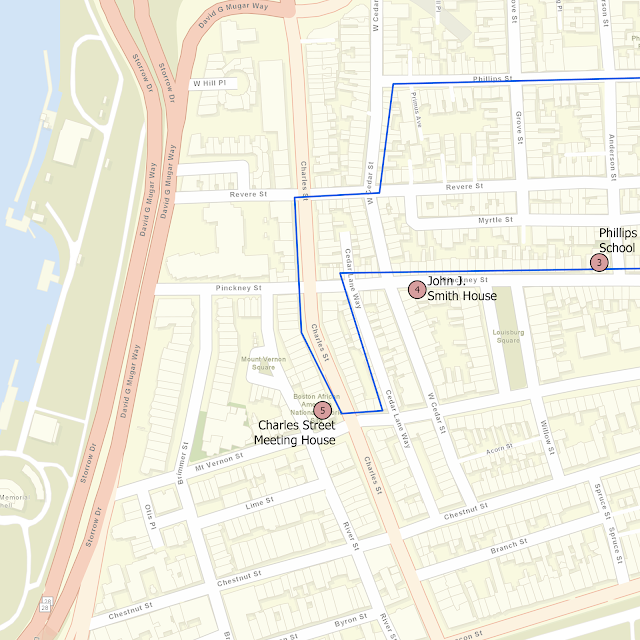Boston: Charles Street Meeting House
Throughout Boston history, meeting houses have been important places. Whether originating as churches or civic gathering points, they have long served as sources of information. From Faneuil Hall to the Old South Meeting House, we've already looked at how certain locations have been critical to how Bostonians have come together to form opinions, exchange ideas, and mold their society. The site we will discover this week symbolizes the city's struggle with race in faith, much as the Phillips School represented the fight for equal education.
Built during the first decade of the 19th century along the waterfront at the edge of Beacon Hill (before additional land was filled in along Charles River), the original congregation that met at the corner of Mt. Vernon St. and Charles St. was that of the Third Baptist Church. As with most locations at that time, segregation existed. Pews were only sold to white members, and black attendees at services had to sit in the gallery. Some 25 years before the first shots of the Civil War at Fort Sumter, an abolitionist member of Third Baptist Church fired his own philosophical shot here by inviting several African Americans to join him in his pew. He was promptly kicked out of the church, at which point he helped found a new church - First Free Baptist Church. This location, which later became Tremont Temple, was America's first integrated congregation and stood between King's Chapel and Park Street Church along the modern Freedom Trail.
In spite of its initial failures in race relations, Third Baptist Church did eventually become friendly to the cause of black Bostonians and the abolitionist movement. Frederick Douglass, William Lloyd Garrison, and Soujourner Truth were among the anti-slavery speakers whose voices were eventually heard within the walls of the church. Shortly after the war's conclusion, however, membership numbers faded and the congregation was largely absorbed by another nearby church before this building was sold. In 1876, it became the home of First African Methodist Episcopal Church, the largest of Boston's black congregations. In addition to regular church services, the building became a focal point for social and political conversations. Ministers such as John T. Jenifer spoke of church reform, civil rights, social ills, and even international politics. In 1889, the Charles Street Meeting House witnessed the creation of a club that would eventually become the National Association of Colored Women, which sought suffrage and other opportunities for all women, especially those of African American descent.
A proposed expansion of Charles Street threatened the building in 1920, and the congregation raised funds necessary to move the building approximately 10' to accommodate construction. Unfortunately this was a significant economic strain on the membership. By 1939, the demographics of the surrounding neighborhood had changed to the point that the church decided to move - this time for real - and they relocated south to their present location in Roxbury. The Charles Street A.M.E. Church is considered the final black institution to leave Beacon Hill. The building was sold to a preservation society, and used for a time both as an Albanian Orthodox church and as a Unitarian Universalist temple. The inside of the structure was continually modified, but the external features remained consistent throughout the years. In 1980, the Charles Street Meeting House Associates acquired the property and repurposed the building's interior while restoring the historic exterior. The modern mixed use of retail, office, and residential space has won several awards for both architecture and preservation.



Very interesting the changes it went through
ReplyDelete